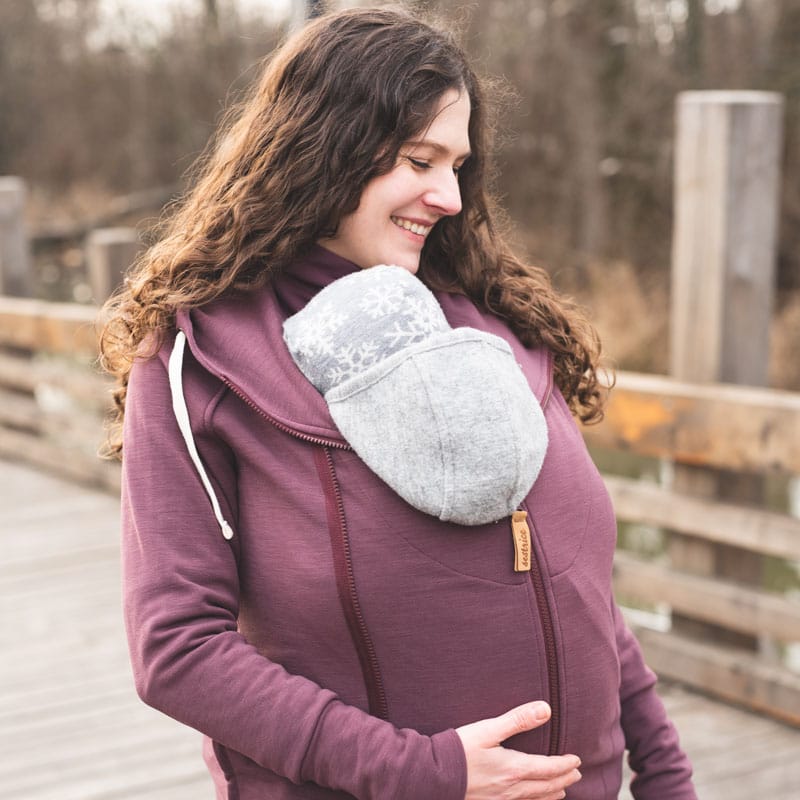Ako obliecť dieťa pri nosení?

Nosenie detí sa stáva čoraz viac populárne. Na trhu preto pribúda mnoho pomôcok na „obliekanie“ detí počas nosenia – od funkčného oblečenia, rôznych chráničov končatín až po nosiace oblečenie pre rodičov, ktoré poslúži zároveň aj deťom. Treba sa však na túto tému pozerať z viacerých uhlov pohľadov a so zreteľom na pohodlie ako dieťatka, tak aj vás.
Je rozdiel, či nosíte staršie (chodca) alebo menšie dieťa (nechodca) a ako obe tieto vekové skupiny oblečiete do interiéru, exteriéru a do konkrétneho počasia.
V zásade je najpohodlnejšie pre oboch obliekať dieťa čo najmenej a v prípade potreby vrstviť teplé veci a rôzne nosiace príslušenstvo priamo na seba a dieťa. Takto menej oblečené ho viete lepšie do šatky alebo nosiča uložiť a podsadiť. Dieťatko sa tiež cíti lepšie menej naobliekané. Vrstvy dokážete aj počas dlhšieho pobytu vonku lepšie prispôsobovať aktuálnemu počasiu (vyzliecť bundu a nechať si mikinu alebo naopak).
Pocit, či je dieťatku teplo alebo zima, môžete odsledovať aj na sebe. Pri nosení si s dieťatkom vymieňate teplotu a vyrovnáva sa vám do rovnakej hladiny (termoregulácia pri nosení, ktorá sa ale stráca obojstranným vrstvením oblečenia). Ak je zima vám na tých častiach tela/chrbta, kde máte šatku, bude pravdepodobne aj dieťatku. Ak sa potíte, bude sa potiť aj ono. Na vašich hrudníkoch sa pravdepodobne budete potiť spoločne, keďže na týchto miestach prebieha najväčšia výmena tepla. Ak je vám tento stav nepohodlný, môžete si napr. vy obliecť tenké tielko alebo tričko, ktoré bude absorbovať pot.
Poďme sa na to pozrieť bližšie v jednotlivých situáciách:
Obliekanie v interiéri (chodci aj nechodci)
V interiéri máte v zásade väčšinou ustálenú teplotu, a preto platí, že dieťa oblečte tak ako seba, prípadne vôbec. Šatka mu z chrbtovej strany poskytuje jednu vrstvu navyše alebo slúži namiesto jednej vrstvy, v ktorej je oblečené, keď je mimo šatky. Vaše telo ho zároveň z druhej strany zohrieva, čiže slúži ako deka alebo radiátor. Jediné miesta, ktoré potrebujete ochrániť pred chladom v chladnejších dňoch a pri poriadne vyvetranom byte, sú časti tela, ktoré má dieťatko vonku zo šatky – väčšinou nožičky a hlavičku, pri starších aj ruky. Na nožičky môžete použiť bavlnené návleky alebo ponožky. Ruky netreba špeciálne zatepľovať a hlavičku v interiéri tiež nie.
Obliekanie nechodcov v lete
V lete sa obliekajte podobne ako v interiéri – čo najmenej. Trčiace nôžky môžete, ale tiež nemusíte, zakryť pred slnkom, ideálne bambusovými alebo tenkými bavlnenými ponožkami a na hlavičku tenkú čiapočku alebo klobúčik ako ochranu pred slnkom. Aby sa drobec necítil nepohodlne, keď sa spotí, môžete mu obliecť napr. funkčné tričko s podielom merino vlny, hodvábu či bambusu, ktoré je priedušné, odsáva pot z tela a prepúšťa ho do ďalšej vrstvy. Pri večerných prechádzkach sa môžete obaja spolu zahaliť napríklad do tenšej funkčnej mikiny Smart Hoodie 02.
Obliekanie nechodcov v zime
Pri nechodcovi si ešte stále môžete dovoliť možnosť vrstvenia a pohodlnosť, ktorú ponúka. Stačí, ak v zimných mesiacoch vymeníte tielko alebo tričko s krátkym rukávom za tričko s dlhým rukávom, pridáte pančušky a pokračujete ako v lete, či interiéri. Teda, prečnievajúce časti tela dooblečiete – na nôžky návleky alebo nejaké vlnené čižmičky pre nechodcov (možná aj kombinácia), na hlavu teplú vlnenú čiapku a pridáte aj nákrčník na krk, ktorý zabráni prístupu chladu zhora medzi vás a dieťa, keď nebude dieťatko akurát spať a mať o vás opretú hlavičku. Seba aj dieťatko môžete vrstviť buď v ideálnom prípade nosiacou mikinoua nosiacou bundou (špeciálne mikiny a bundy, ktoré sú navrhnuté tak, aby ste ich vedeli pohodlne nosiť, či už na sebe máte bábätko, alebo aj bez neho), alebo použijete nosiacu kapsu. Vašu bundu si tak necháte rozopnutú, aby bolo dieťatko stále čo najbližšie pri vašom tele a mohlo sa tak najviac zohrievať.
Odporúčame používať aj pre vás nákrčník, ktorý chráni Váš krk a dekolt, keď máte dieťatko na sebe pod mikinou alebo kapsou.
Obliekanie chodcov v lete
Nemusíte ich nijako špeciálne obliekať. Tým, že už samostatne chodia, prispôsobujete im oblečenie aj mimo nosenia.
Obliekanie chodcov v zime
S chodcami tiež môžete využiť metódu vrstvenia, aj keď je to už troška náročnejšie, keďže sú oblečení na samotný pobyt vonku. Ak chodca idete ponosiť len na chvíľu, postačí vloženie do šatky alebo nosiča na vašu bundu (je to stále ďalšia vrstva, ktorá zohrieva). Avšak POZOR! Keďže vy máte bundu, aj váš drobec, nefunguje už vaša telesná termoregulácia, čiže sa nezohrievate navzájom. Ak by jeho pobyt v šatke mal byť na dlhšie, dajte si ho aspoň pod nosiacu kapsu. Chodidlá a lýtka vo visiacej polohe vždy viac vychladnú, preto je dobré navrstviť ich ešte návlekmi.
V prípade, že si ho dáte pod nosiacu bundu, jemu bundičku môžete tiež vyzliecť. Hlavné je, aby ste boli obaja chránení zvrchu a neprenikal medzi vás a váš vzájomný ohrev chlad. Opäť odporúčame použiť nákrčníky.
Takto môžete nosiť samozrejme aj nechodcov. Je to však menej pohodlnejšia varianta a nesiete aj väčšiu váhu v šatke.
Kombinácií, ktoré môžete využiť, je samozrejme viac. Pre ktorú z nich sa rozhodnete, to vždy závisí od aktuálnej situácie a od toho, čo vyhovuje práve vám dvom.

No Komentáre